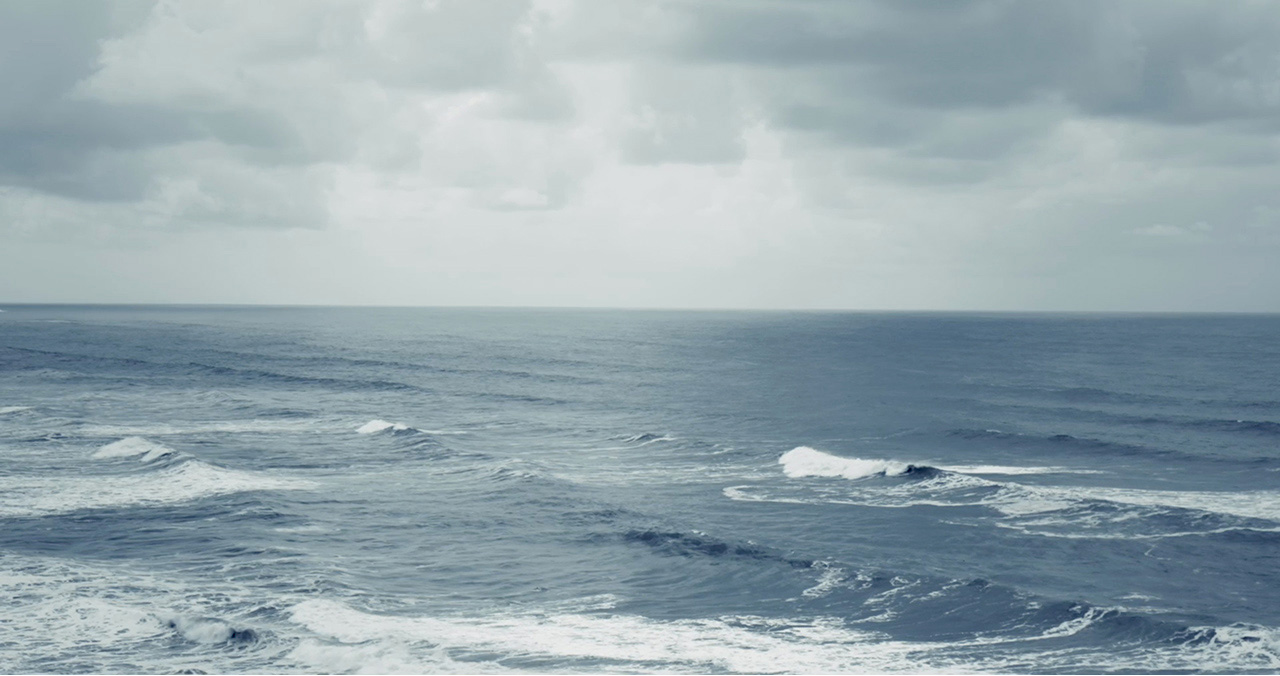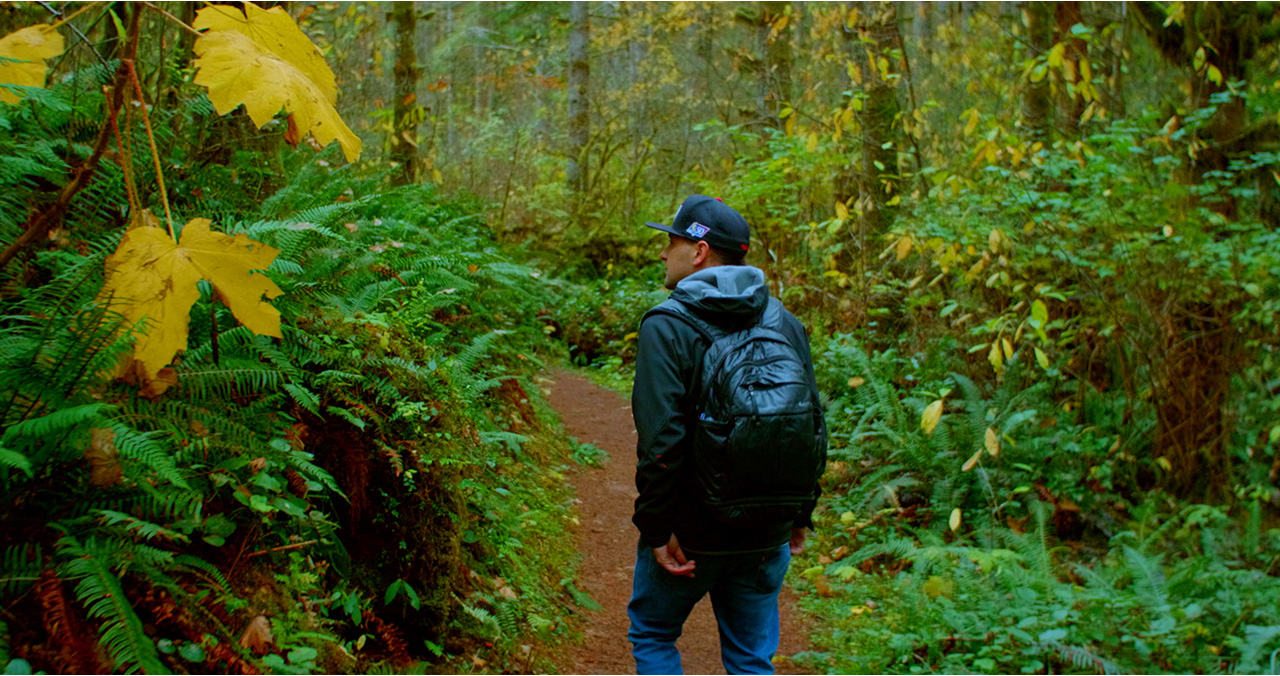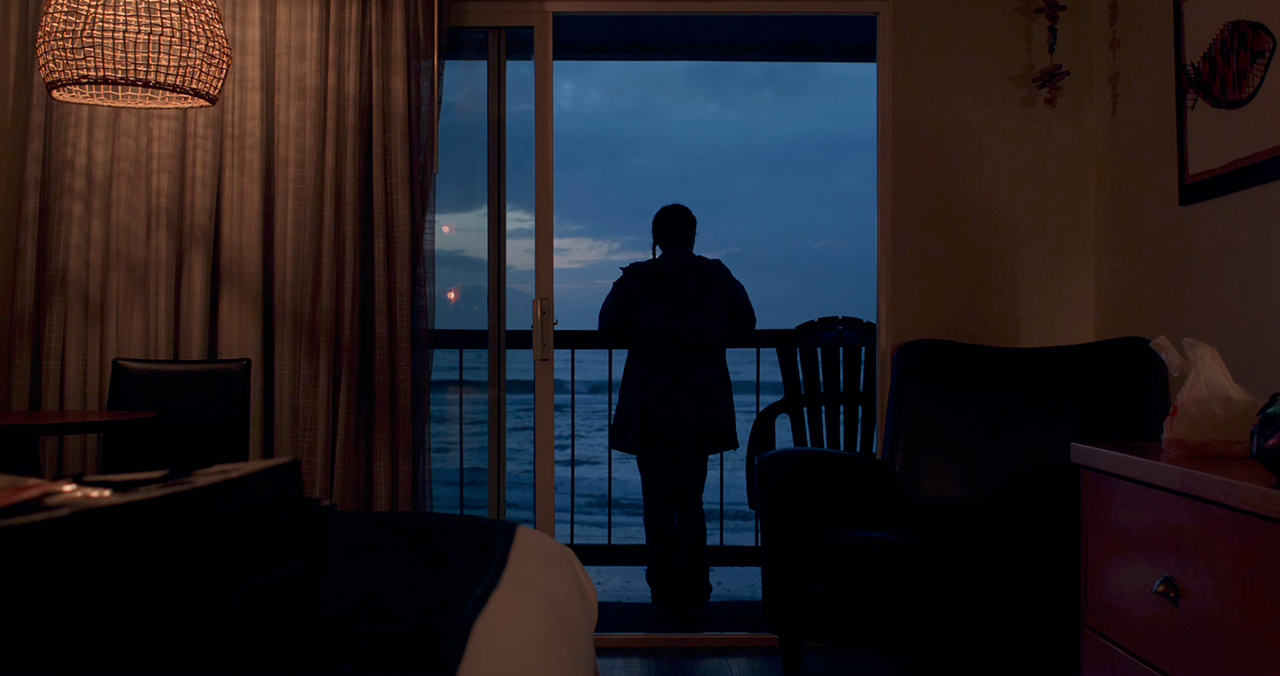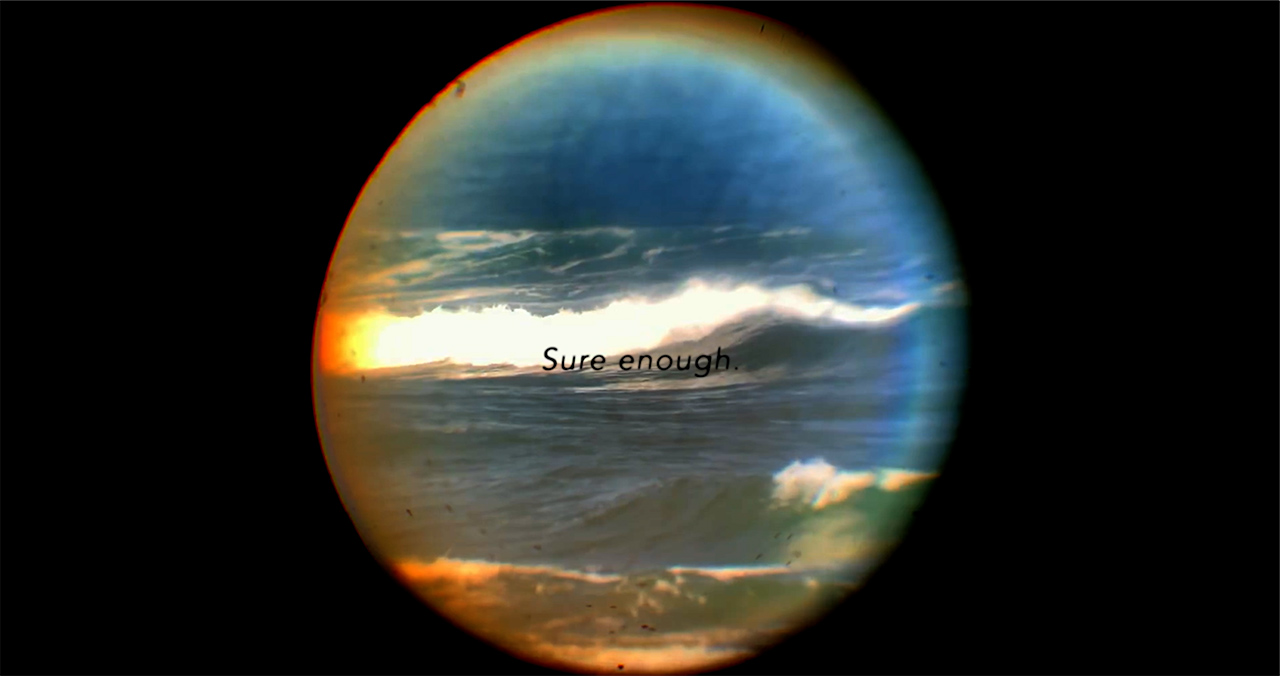Japan Premiere! Screenings: 8/11 (Thu) 8pm (outdoor and indoor), 8/14 (Sun) 3:30pm (indoor), Online UPAF (9/3-11, worldwide)
A debut feature and a gift to the world from Sky Hopinka, one of the hottest and coolest and gentriest Indigenous filmmakers today. The first Chinuk Wawa-spoken feature-length film in the world. with English subtitles and Japanese subtitles for Deaf and Hearing-impaired.
A poetic, experimental debut feature circling the origin of the death myth from the Chinookan people in the Pacific Northwest, małni – towards the ocean, towards the shore follows two people as they wander through their surrounding nature, the spirit world, and something much deeper inside. At its center are Sweetwater Sahme and Jordan Mercier, who take separate paths contemplating their afterlife, rebirth, and death. Probing questions about humanity’s place on earth and other worlds, Sky Hopinka’s film will have audiences thinking (and dreaming) about it long after.
Sky Hopinka (Ho-Chunk Nation/Pechanga Band of Luiseño Indians) was born and raised in Ferndale, Washington and spent a number of years in Palm Springs and Riverside, California, Portland, Oregon, and Milwaukee, Wisconsin. In Portland he studied and taught chinuk wawa, a language indigenous to the Lower Columbia River Basin. His video, photo, and text work centers around personal positions of Indigenous homeland and landscape, designs of language as containers of culture expressed through personal, documentary, and non fiction forms of media. http://www.skyhopinka.com/
His work has played at various festivals including Sundance, Toronto International Film Festival, Ann Arbor, Courtisane Festival, Punto de Vista, and the New York Film Festival. His work was a part of the 2017 Whitney Biennial, the 2018 FRONT Triennial and Prospect.5. He was a guest curator at the 2019 Whitney Biennial and participated in Cosmopolis #2 at the Centre Pompidou. He has had a solo exhibition at the Center for Curatorial Studies, Bard College, in 2020 and at LUMA Arles in Arles, France in 2022. He was awarded the Tom Berman Award for Most Promising Filmmaker at the 54th Ann Arbor Film Festival, and the New Cinema Award at the Berwick Film and Media Arts Festival. He was a fellow at the Radcliffe Institute for Advanced Study at Harvard University in 2018- 2019, a Sundance Art of Nonfiction Fellow for 2019, an Art Matters Fellow in 2019, a recipient of a 2020 Alpert Award for Film/Video, a 2020 Guggenheim Fellow, and was a 2021 Forge Project Fellow.
2020, 80min, non-fiction based “experimental” film, color, USA.
—
Excerpts from Splittooth interview:
Split Tooth Media: With vast oceans, sparkling beaches, rocky cliffs, and dense forests, you portray the Pacific Northwest as a wide-ranging landscape in maɬni. Your work often highlights the natural beauty of the environment, but how did you want to communicate the particular aesthetics of the Pacific Northwest in maɬni?
Sky Hopinka: I remember really wanting to make a film on the Oregon Coast because it’s where I grew up. I love the gray skies and the rainy weather. I think it’s really beautiful. I had been wanting to make a film that captures that visually. maɬni really provided an opportunity to do that. Or it’s the excuse that I made to go do that, [in order] to revisit friends, to revisit these landscapes, and to try and capture the beauty of a gray Northwest spring.
In maɬni there is a central emphasis on water. We see Sweetwater Sahme do a waterfall cleanse, Jordan Mercier and others row traditional Chinookan canoes, and you also explore the Chinookan death myth where the ocean is tied to their vision of the afterlife. How did you aim to integrate the sacred connection between indigenous people and water into the overall composition of maɬni?
By presenting it in a way that is quotidian. I think presenting these things being inhabited, being used, being engaged with, not necessarily in a reverential way — though the reverence is there — but in a way that demonstrates that this is part of everyday life is really important for bridging those ideas.
—
How do you approach exploring the distant history of indigenous people versus chronicling contemporary events, like the Standing Rock Protests in Dislocation Blues (2017)?
I mean, the history is present every day. I don’t know if that sounds corny, but what we are living in today is an accumulation of those pasts, and those histories and those traumas and those joys and those things that have survived. And what’s also felt today in the present is a sense of mourning or loss of those things that didn’t make it or that you don’t have access to or that are gone. I am a big proponent of thinking about the present, or not necessarily thinking about the future or indigenous futurisms or futurisms in general. I think that’s important, but also, what are the things that are manifested everyday that are the intersection of the past and the future, which is, I guess, the present?
We see powerful performances of singing, drumming, dancing, and poetry in your films. What is it like experiencing, capturing, and presenting these intense performances?
I think they are fun to film. But also, I don’t film anything that isn’t meant to be filmed. There is a sense of sharing or to be observed in the Pow Wow or the drum group in maɬni. Just thinking about how people are presenting themselves, and how they want to be seen, and what am I getting permission to record and to film and to look at. It feels like there’s a play between the two. I think that film is a good medium for that, to let those who wish to be seen be seen. And also to give privacy and space to the things that aren’t supposed to be filmed or aren’t supposed to be seen.
Do you find that sense of illusion or obfuscation of the landscape extends to some of your other films as well?
Yeah, I’m always trying to find ways to film landscapes or to film places that are interesting to me. Not necessarily trying to be novel every time, but just trying to figure out what can a camera do in this place or what things are going on that I can respond to with the camera. That’s part of the joys of shooting: figuring out what I can do in a place with the camera, what can I do in camera, and then also what can I do in post.
For me that’s the joy of experimental film too, seeing how filmmakers can warp reality through their lens in that way.
Yeah, absolutely. You have a camera but every person is going to do something different with it. ‘Experimental’ cinema is a loaded word, it’s an empty word, but I like how empty it is. It adapts. What’s experimental to one person might not be to another. That gives a lot of room in a very small space for people to do different and exciting things.
—
Cinema has a long history of stereotyping indigenous peoples. As a filmmaker who presents indigenous culture from such a personal, respectful perspective, how can one counteract the more harmful examples from cinema’s past?
I think just having more space for more work by indigenous people that are either commenting on that history or just totally ignoring it. A thing I have tried to avoid is feeling like I have to respond to the canon or respond to those histories. I don’t want my films to just be responses to white perceptions about who we are or what we do. I’m a fan of work that cuts that part out of the equation, but I also love the work that comments on it in a really direct and aggressive way. The work of New Red Order is fantastic and necessary and needed, and so is the work of Fox Maxy and other indigenous filmmakers that are asking different questions. There are so many questions to be asked that could not necessarily be answered, but could be facilitated through film.
If you want to read the whole interview, click here.



